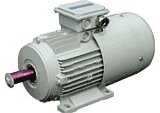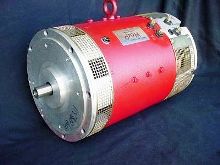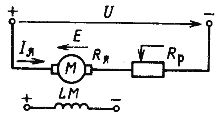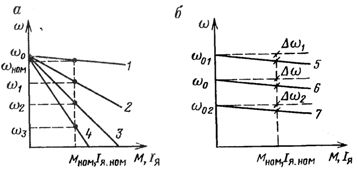Speed control of a DC motor
 From the electromechanical characteristic equation permanent engine independent excitation, it follows that there are three possible ways to control its angular velocity:
From the electromechanical characteristic equation permanent engine independent excitation, it follows that there are three possible ways to control its angular velocity:
1) regulation by changing the resistance value of the rheostat in the armature circuit,
2) regulation by changing the excitation flux of the motor F,
3) adjustment by changing the voltage applied to the armature winding of the motor U... Armature circuit current AzI and the moment M developed by the motor depend only on the magnitude of the load on its shaft.
Consider the first method of controlling the speed of a DC motor by changing the resistance in the armature circuit ... The motor circuit diagram for this case is shown in Fig. 1, and the electromechanical and mechanical characteristics are shown in Fig. 2, a.
Rice. 1. Circuit diagram of a DC motor with independent excitation
Rice. 2. Mechanical characteristics of a DC motor at different armature circuit resistances (a) and voltages (b)
By changing the resistance of the rheostat in the armature circuit, it is possible at nominal load to obtain different angular speeds of the electric motor by artificial characteristics — ω1, ω2, ω3.
Let's analyze this method of controlling the angular velocity of DC motors using the main technical and economic indicators. Since this method of adjustment changes the stiffness of the characteristics in a wide range, then at speeds below half of the nominal, the stability of the engine's operation deteriorates sharply. For this reason, the speed control range is limited (e = 2 — H).
With this method, the speed can be adjusted down from the basic one, which is proven by the electromechanical and mechanical characteristics. It is difficult to ensure high smoothness of regulation, since a significant number of control steps and a correspondingly large number of contactors will be required. Full use of the motor for current (heating) in this case is achieved with constant load torque regulation.
The disadvantage of this method is the presence of significant power losses during adjustment, which are proportional to the relative change in angular velocity. The advantage of the considered method of angular velocity control is the simplicity and reliability of the control circuit.
Given the high losses in the rheostat at low speeds, this method of speed control is used for drives with short-term and intermittent-short duty cycles.
 In the second method, the control of the angular velocity of DC motors of independent excitation is carried out by changing the magnitude of the magnetic flux due to the introduction of an additional rheostat in the circuit of the excitation winding. When the flow is weakened, the angular velocity of the engine both under load and at idle speed increases, and when the flow rate increases, it decreases. It is practically possible to change the speed only up due to the saturation of the engine.
In the second method, the control of the angular velocity of DC motors of independent excitation is carried out by changing the magnitude of the magnetic flux due to the introduction of an additional rheostat in the circuit of the excitation winding. When the flow is weakened, the angular velocity of the engine both under load and at idle speed increases, and when the flow rate increases, it decreases. It is practically possible to change the speed only up due to the saturation of the engine.
As the speed increases by weakening the flux, the allowable torque of the DC motor changes according to the hyperbola law, while the power remains constant. Speed control range for this method e = 2 — 4.
The mechanical characteristics for different values of motor flux are shown in Fig. 2i and 2, b, from which it can be seen that the characteristics within the rated current have a high degree of stiffness.
The field windings of independently excited DC motors have significant inductance. Therefore, with a step change in the resistance of the rheostat in the field winding circuit, the current and therefore the flux will change exponentially. In this regard, angular velocity control will be performed smoothly.
The main advantages of this speed control method are its simplicity and high efficiency.
This control method is used in drives as an auxiliary, providing an increase in the idle speed of the mechanism.
The third way to control speed is to change the voltage applied to the armature winding of the motor.The angular velocity of a DC motor, regardless of load, varies in direct proportion to the voltage applied to the armature. Since all control characteristics are rigid and their degree of stiffness remains unchanged for all characteristics, motor operation is stable at all angular velocities and therefore a wide range of speed control is provided regardless of load. This range is 10 and can be extended by special control schemes.
With this method, the angular velocity can be decreased and increased relative to the basic one. Acceleration is limited by the AC voltage source capabilities and the motor's Unomer.
If the power source provides the ability to continuously vary the voltage applied to the motor, then the motor speed control will be smooth.
This control method is economical because the angular velocity control of an independently excited DC motor is performed without additional power losses in the armature supply circuit. For all the above indicators, this method of regulation is the best compared to the first and second.


